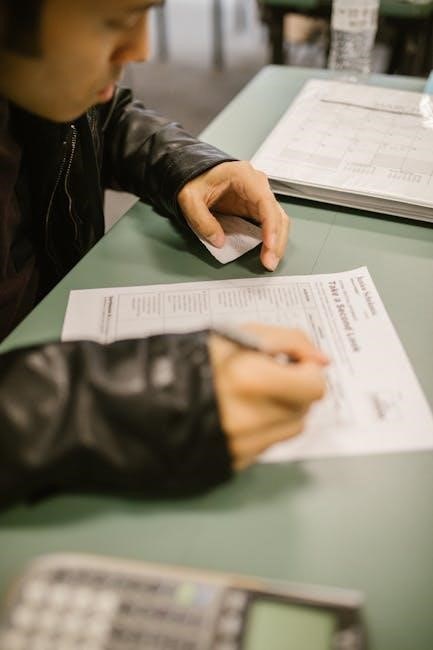unit 3 test study guide relations and functions answer key
Overview of Relations and Functions
A relation is a set of ordered pairs, and a function is a special type of relation where each input corresponds to exactly one output.
In the context of the unit 3 test study guide, relations and functions are fundamental concepts in algebra.
The study guide provides an overview of these concepts, including definitions, examples, and explanations of key terms.
Students can use online resources, such as Brainly, to supplement their understanding of relations and functions.
The guide also covers topics like domain and range, which are essential for understanding functions.
By reviewing the overview of relations and functions, students can develop a solid foundation for more advanced topics in algebra.
The unit 3 test study guide is a valuable resource for students preparing for the test, and it provides a comprehensive overview of relations and functions.
The guide is designed to help students understand the material and prepare for the test, and it includes many examples and explanations to illustrate key concepts.
Overall, the overview of relations and functions is an important part of the unit 3 test study guide, and it provides students with a thorough understanding of these fundamental concepts.
The guide is a useful tool for students who want to succeed in algebra, and it provides a clear and concise overview of relations and functions.

Understanding Domain and Range
Understanding domain and range involves identifying input and output values in a function, using online resources for guidance and practice problems.
Definition of Domain and Range
The domain of a function is defined as the set of all possible input values, while the range is the set of all possible output values. This concept is crucial in understanding relations and functions, as it helps identify the restrictions and limitations of a function. According to online resources, the domain and range can be determined using various methods, including mapping diagrams and tables. The domain is typically represented by the x-values, while the range is represented by the y-values. By understanding the definition of domain and range, students can better analyze and work with functions, including identifying the type of function and determining its graph. Additionally, online study guides and resources provide detailed explanations and examples to help students grasp this concept and apply it to solve problems. Overall, the definition of domain and range is essential in algebra and functions.

Calculating Domain and Range
Calculating domain and range involves analyzing functions and identifying input and output values using tables, graphs, and equations to determine restrictions and limitations always with online resources available.
Examples of Domain and Range Calculations
Examples of domain and range calculations are crucial in understanding relations and functions.
For instance, given a function with ordered pairs, we can calculate the domain and range by identifying the input and output values.
We can use tables, graphs, and equations to determine the domain and range of a function, considering any restrictions or limitations.
Online resources provide step-by-step examples and exercises to practice calculating domain and range, helping students to master this concept and apply it to various problems.
By analyzing different examples, students can develop a deeper understanding of how to calculate domain and range, which is essential in algebra and other math disciplines.
These examples also help students to identify the relationships between the domain, range, and the function itself, enabling them to solve problems more effectively and efficiently.
Moreover, examples of domain and range calculations can be used to illustrate key concepts, such as one-to-one functions and inverse functions, and to demonstrate how to use domain and range to determine the nature of a function.
Overall, examples of domain and range calculations play a vital role in helping students to grasp and apply this fundamental concept in mathematics.

Types of Relations and Functions
Types of relations and functions include one-to-one, many-to-one, and one-to-many, which are essential concepts in algebra and mathematics, often represented using tables, graphs, and equations clearly always.
Identifying Functions and Non-Functions
To identify functions and non-functions, we need to analyze the given relation and determine if each input corresponds to exactly one output. This can be done by using the vertical line test, where a vertical line is drawn on the graph of the relation. If the line intersects the graph at more than one point, then the relation is not a function. On the other hand, if the line intersects the graph at only one point, then the relation is a function. We can also use the definition of a function to identify functions and non-functions, which states that a function is a relation between a set of inputs and a set of possible outputs, where each input is related to exactly one output. By applying these methods, we can determine whether a given relation is a function or not, and this is an essential skill in algebra and mathematics, as it helps us to work with functions and relations in a more effective way, and to solve problems and equations that involve functions and relations, and to graph functions and relations on a coordinate plane, and to identify the domain and range of a function or relation, and to determine if a function or relation is one-to-one, onto, or both.

Resources for Further Study
Online resources and study materials are available for further study and practice of relations and functions concepts always using websites and textbooks.
Online Resources and Study Materials
There are various online resources and study materials available to help students learn and practice relations and functions concepts, including websites such as Brainly and Quizlet.
These websites provide detailed explanations, examples, and practice problems to help students understand the concepts of domain and range, and how to determine if a relation is a function.
Additionally, online textbooks and study guides, such as the Unit 3 Test Study Guide Relations and Functions Answer Key, provide step-by-step solutions and explanations to help students prepare for tests and quizzes.
Students can also use online flashcards and games to memorize key terms and concepts, and to test their understanding of the material.
Overall, online resources and study materials can be a helpful supplement to traditional classroom instruction, and can provide students with the support and practice they need to succeed in algebra.
By using these resources, students can gain a deeper understanding of relations and functions, and develop the skills and confidence they need to excel in math.
Online resources are easily accessible and convenient to use, making them a great option for students who need extra help or review outside of class.
Answer Key and Solutions
The answer key provides step-by-step solutions and explanations to help students understand relations and functions concepts clearly and accurately always with detailed examples and answers.
Step-by-Step Solutions and Explanations
The step-by-step solutions and explanations provide a clear understanding of relations and functions concepts, helping students to identify and solve problems accurately and efficiently.
Each solution is broken down into manageable steps, making it easier for students to follow and understand the reasoning behind each answer;
Additionally, the explanations offer insights into the underlying concepts and principles, enabling students to develop a deeper understanding of the subject matter and apply it to various problems and scenarios.
By working through the step-by-step solutions and explanations, students can build their confidence and proficiency in relations and functions, ultimately achieving better results in their unit 3 test and future math endeavors.
Overall, the step-by-step solutions and explanations are an essential resource for students seeking to master relations and functions and succeed in their math studies.
